Het zou de ideale zwoele zomeravond kunnen zijn: een filmpje kijken onder een idyllische sterrenhemel. Op de herfstachtige avond van vrijdag 6 september blijkt openluchtbioscoop Zienemaan en Sterren echter meer een oefening in uithoudingsvermogen. Het regent, de temperatuur daalt, maar het Groningse publiek blijft onverstoord zitten: kop d’r veur en parapluutje open.
“Iedere stad had een openluchtbioscoop behalve Groningen. Dat is natuurlijk belachelijk!” zegt organisator Jorine Witte. “Het is zo’n goed concept om mensen op een laagdrempelige manier in aanraking te laten komen met mooie films,” vertelt programmeur Harmen Huizenga.” Jorine en Harmen werkten samen bij Zienema, de bioscoop van poppodium VERA waar zij iedere dinsdagavond bijzondere films vertoonden. Jorine: “Wij voelden ons geroepen om ook in Groningen een openluchtbioscoop op de kaart te zetten.” Zo begon Zienemaan en Sterren ooit in 2011 in het klein op het Groningse Ebbingekwartier met een breed filmdoek voor een grasveld.
Het decor voor de ideale instagramfoto
Inmiddels beleeft Zienemaan en Sterren haar achtste editie en is uitgegroeid tot de grootste openluchtbioscoop van Noord-Nederland. Het voormalige suikerunieterrein is de thuishaven van dit driedaagse filmfestival. Het is een prachtlocatie en lijkt het decor voor de ideale instagramfoto: achter het filmdoek baadt de suikerfabriek in een mysterieuze paarse gloed, de gekleurde lampjes van de barretjes steken gezellig af bij de industriële setting. Op vrijdag 6 september bezoek ik het festival. Zienemaan en Sterren doet dan zijn naam eer aan met een heuse Russische ruimtefilm: Salyut 7.

De Fatboys liggen uitnodigend klaar, knusse kleedjes hangen over de stoelen en de eerste gasten nemen ze al in gebruik. Linda en Rinze uit Roden zijn er vroeg bij. Op de eerste rij zitten zij klaar voor een reis naar de ruimte. Google bracht ze naar Zienemaan en Sterren: “We zijn een avondje uit in Groningen en zochten op internet naar een leuk evenement. Het was dit of stoelendansen op de Grote Markt,” vertelt Linda. Er staat een buitje gepland, maar zijn ze voorbereid op de regen? Het antwoord luid kort “nee.” Ze kruipen iets verder onder hun dekentje.
“Russische Ruimtevaart is veel toffer dan NASA!”
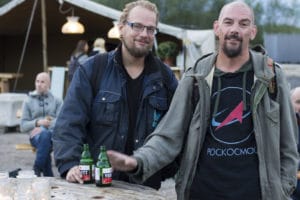
Minstens zo slecht voorbereid zijn Remon en Peter. Deze twee stoere mannen vind ik -zoals gebruikelijk- bij een statafel met een biertje in de hand. “Wij zijn heel goed voorbereid op de regen,” grapt Peter, “als in: wij hopen heel erg hard dat het niet gaat regenen.” “Kijk!” wijst Remon hoopvol, “die wolk daar trekt al weg!”
Noch Remon noch Peter zijn eerder op Zienemaan en Sterren geweest, terwijl zij beiden werkzaam zijn bij VERA en daarmee bekend met het concept. Het was de film die dit keer de doorslag gaf. Remon toont trots zijn T-shirt. Ik lees Pockockmoc, “Roskosmos,” verklaart Remon, hij blijkt een kenner van de Russische spelling, “je kunt mijn naam ook als ‘Pemoh’ schrijven.” Wat volgens Pemoh een Russische film over ruimtevaart zo aanlokkelijk maakt: “Russische ruimtevaart is veel toffer dan NASA; ze waren overal eerder”. “En het verhaal uit de film is waargebeurd.” vult Peter aan. “Ah, net zoals de Amerikaanse maanlanding?” vraag ik. Peter lacht. Hij maakt zijn vingers tot aanhalingstekens, “Ja, ‘waargebeurd’.”
“Ik heb niets met Science-Fiction”
Op de vrijdagavond van Zienemaan en Sterren komt het thema ruimte op verschillende manieren terug: er staat een door sponsor Vedett geleverde raket en er schalt een ruimteplaylist door de speakers. Terwijl David Bowie met Space Oddity aftelt voor de film; 10, 9, 8… telt een bezoeker achter mij voor iets anders af: “3, 2, 1 hoppa”, met zijn billen droogt hij de natte stoel. Deze bezoeker blijkt zich minder goed te hebben ingelezen: “Ik moet je heel eerlijk zeggen: ik heb niets met Science-Fiction,” zegt hij tegen zijn metgezel. “Huh? Maar ik dacht dat jij zo’n spaceman was!” “Nee ik houd van Space Oddity das heel iets anders!”
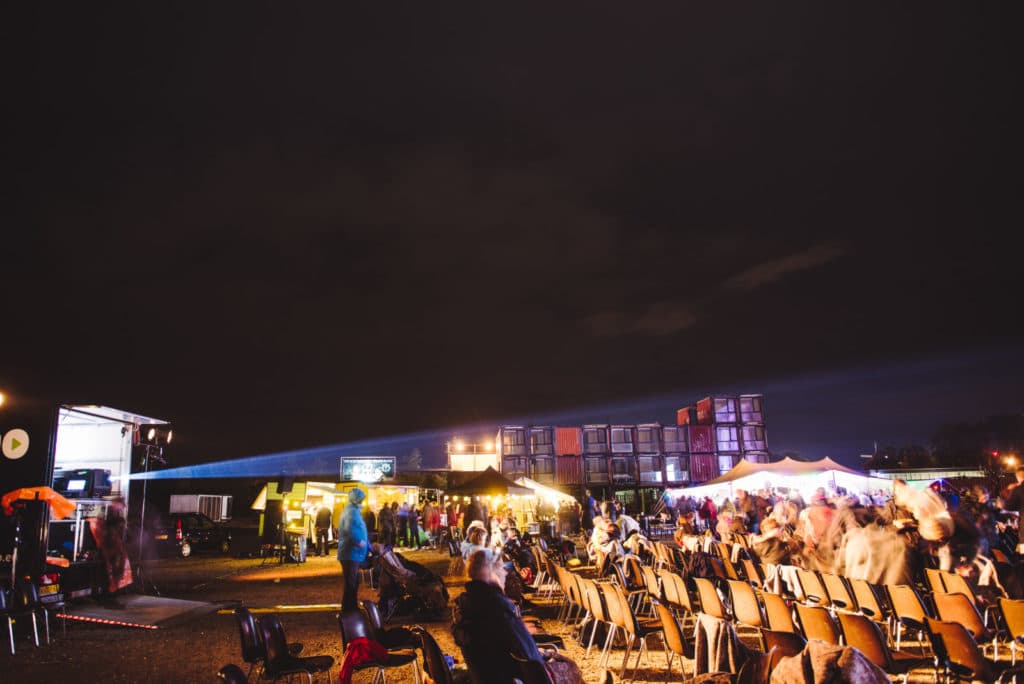
De film van de avond Salyut 7 heeft niets met Science-Fiction te maken. Salyut 7 vertelt het waargebeurde verhaal van de tot op heden meest technisch uitdagende missie in de ruimtevaart. Als het Russische controlecentrum in 1985 het contact verliest met het onbemande ruimtestation Salyut 7 slaat de paniek in de Sovjet-Unie toe. Wanneer een rondtollend onbemand object van ruim 20.000 ton neerstort op Aarde zal een catastrofe plaatsvinden. Die ramp wordt uiteraard nog groter als het midden in de Koude Oorlog toevalligerwijs in de VS terechtkomt. Er zit maar één ding op: het ruimtestation bemannen. Salyut 7 is een ijzingwekkend spannende film en biedt een verfrissend ander perspectief.
“Russische ruimtefilms zijn veel meer down to earth”
“De meeste ruimtefilms zijn Amerikaans,” vertelt programmeur Harmen, “en toch was er een andere grote speler in de ruimtevaart: de Sovjet-Unie.” De Russische cinema is volgens Harmen traag, ingetogen en vol twijfel met een vleugje melancholie. Hij merkt gevat op: “Russische ruimtefilms zijn veel meer down to earth. Er is meer focus op het menselijke, het existentiële. Salyut 7 heeft het beste van twee werelden: Het valt precies tussen het bombastische van Hollywood en het ingetogener werk van de Russen.”
Tijdens de film ontnemen donkere wolken het zicht op de maan en sterren. Terwijl de film prachtig gewichtloosheid toont in een scène waar satelliet Salyut 7 vol zwevende waterdruppels zit, vallen in Groningen de druppels naar beneden. De regenponcho’s gaan uit de tas en bezoekers verplaatsen hun stoel om kleurrijke paraplu’s open te klappen. Het is nog altijd sfeervol op het festivalterrein, met een beetje fantasie lijken de paraplu’s net parasols. De temperatuur begint te dalen, maar het is nog altijd niet zo koud als in het Russische ruimtestation op het scherm. Ook de Russische astronauten klagen niet in vliegende vrieskist Salyut 7 “Het is net Sochi in de winter,” zegt de een en haalt zijn schouders op.
“Twee jaar geleden was het nog erger en ook toen bleef iedereen zitten”
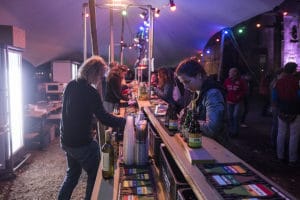
In de pauze warmen de bezoekers zich aan wijn en thee, maar niemand gaat weg. Nait soezen (niet zeuren) lijkt het motto. “Nou je ziet het,” zegt Harmen, “zelfs de regen deert de mensen niet.” Het verbaast mij, net zoals het de organisatie zelf twee jaar eerder verbaasde: “Twee jaar geleden was de regen nog erger en ook toen merkten we dat iedereen bleef zitten. Het gaf ons in ieder geval vertrouwen dat we nog door konden gaan,” vertelt Harmen. “Zolang de film pakkend genoeg is blijft het publiek kijken.” Bij Salyut 7 is dat het geval. De suspense is constant voelbaar door de enorme bombastische soundtrack. Het publiek kan gelukkig af en toe weer ademhalen in schitterende duizelingwekkende shots die doen denken aan Gravity.
“Het eerste jaar was echt een eye-opener”
Salyut 7 is een film die de open lucht aan kan. Harmen: “Ik houd bij het selecteren van een film altijd in mijn achterhoofd of de film blijft staan in de open lucht. Sommige films zijn prachtig, maar toch wat ingetogen en klein. De dialoog moet wel goed overkomen.” Jorine vult aan: “In het eerste jaar hadden we hele luidruchtige films gekozen. We dachten toen: mensen zijn supersnel afgeleid, dus we moeten echt films hebben die de aandacht blijven trekken. Dat eerste jaar was echt een eye-opener voor ons, want wat bleek: iedereen bleef netjes in rijen zitten. Het was veel meer een ‘bioscoop’ dan wij hadden verwacht. Het jaar daarna hebben we wat stillere films geprogrammeerd.”
“Ik probeer zo divers mogelijk te programmeren”
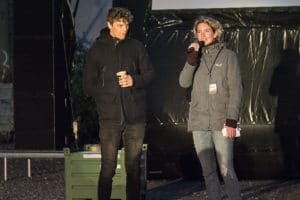
Foto: Obed Brinkman
Het oprekken van de bioscoopconventies is juist iets wat Harmen en Jorine op Zienemaan en Sterren proberen te doen. “We doen nu sinds een paar jaar de concertfilm. Daarbij hopen we dat mensen misschien toch gaan dansen, dat er wat reuring is, net alsof je echt bij een concert staat te kijken. Na eerder concertfilms van Herman Brood, David Bowie en The Talking Heads te hebben getoond, is het voor de achtste editie tijd voor concertfilm Monterey Pop. “Ik probeer altijd zo divers mogelijk te programmeren,” vertelt Harmen, “omdat je dan ook een heel divers publiek aanschrijft. Voor de vrijdag hebben we Russisch en ruimtevaart, voor de zaterdag een concert met hippies en flowerpower, dan zondag punk en aliens in How to Talk to Girls at Parties. Zo is er voor ieder wat wils.”
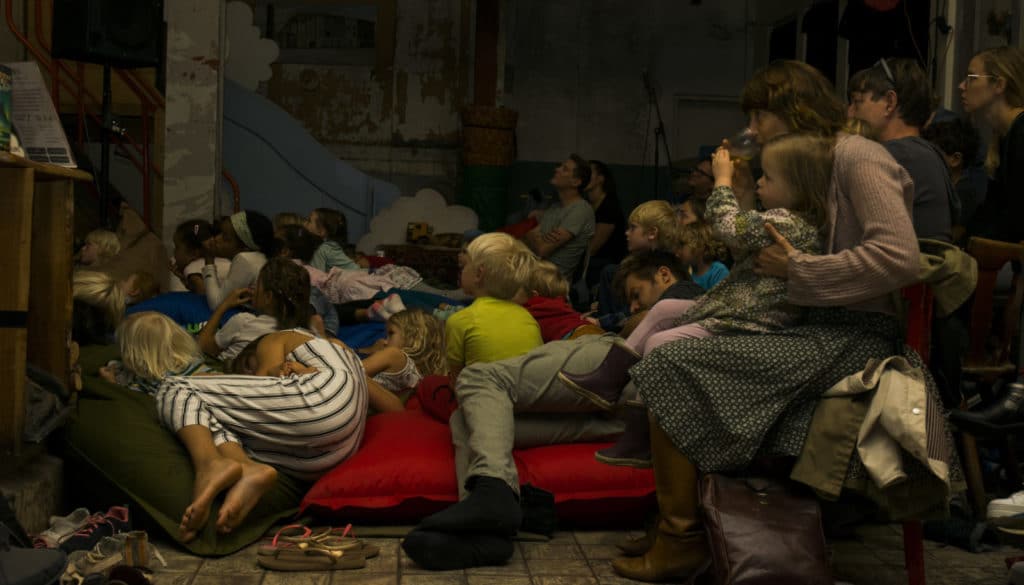
Zelfs kinderen zijn bij Zienemaan en Sterren aan het goede adres. Sinds drie jaar toont de organisatie in de middag kinderfilms in “Zienemini”. Het knusse café in de Suikerfabriek, de Wolkenfabriek, leent zich perfect voor die setting. Moeder Nathaly bezoekt op zaterdagmiddag De dieren uit het Hakkebakkebos met haar dochter en diens vriendinnetje. “We komen ieder jaar naar Zienemini. Het is veel leuker dan een gewone bioscoop. De kinderen kunnen hier rustig van hun plek gaan om te spelen.” Haar dochter komt haar halen: “Snel mama! De film begint!”
“Wij proberen altijd meer te doen dan alleen een film te tonen”
Voor filmfestival Zienemaan en Sterren is een film tonen meer dan slechts op play drukken. Jorine: Ik vind het heel jammer dat de huidige bioscoopbranche enkel een film afdraait; dat kan ook gewoon thuis op de bank. Wij proberen altijd meer te doen dan alleen een film te tonen. We geven een inleiding en laten een deskundige aan het woord als het even kan. Zodat wij met onze filmevenementen echt iets toevoegen.” Zo wordt voor de hoofdfilm altijd een goede korte film getoond. Een genre waar in de reguliere bioscoop geen plek voor is.
“Het moeilijke van een evenement in de openlucht blijft dat je van tevoren nooit weet waar je aan toe bent,” zegt Harmen. “Vorig jaar hadden we een perfecte editie, windstil en een avondzonnetje, dan zit je zo met 700 man. Als het regent zijn de bezoekersaantallen beduidend lager.” Toch maakt een regenachtige nacht bij Zienemaan en Sterren duidelijk dat Groningers niet van suiker zijn. Al dan niet voorbereid laten ze zich niet wegjagen door een beetje water.
Aftermovie: Joris Bakker
